
Before starting this review I would like to congratulate the collaborators Hijinx and Punchdrunk Enrichment on arguably the most incredible and engaging immersive, site specific performance that I have ever had the pleasure of participating in, a bold statement that I hope this review provides justification for.
“We’ve all lost something: glasses, keys, memories, love, loved ones, our way…Are these things gone forever or have they found a home elsewhere? Hidden in Cardiff is a world of lost things. In the shadows, behind closed doors, we await you”
On Wednesday the 1st of July I joined a steadily growing queue outside the Maldron Hotel in Cardiff to see Beneath The Streets: Lost and Found. An exciting buzz of anticipation was rippling through the audience and before long a briefing on what was to come was delivered, along with mandatory dust masks. The buzz was now turning into excited curiosity as we were led to the front doors of Jacob’s Antiques Market.
Upon entering the space I was immediately drawn to the attention of detail that had been used. Given that I am familiar with the regular layout of Jacob’s Antiques Market I was extremely impressed with how the design team and stage carpenter had utilised the space given to create this incredibly beautiful maze spanning two floors. I will admit I had trouble finding my way around for the first 15 minutes. Everywhere you went you were met with a corner, a drape or darkness! Opening doors to nothingness, dim lighting that cast shadows over performers and beautiful decorations adorning different sections of this new world.
My particular favourite was a pyramid made from pages and pages of books in the section of lost words, the impressive set design continued as I found myself being led by an actor into a dark room lit with a few candles, to be told a tragic love story, only to find him conversing through a non-existent mirror with his lady-love. An extremely clever trick that left myself and the other audience member, that had been lured to the ‘other room’, in complete shock. Upon discovery of the lower lair I came across sets of actors telling different stories, all looking for something or finding something. Ascending to the upper we were greeted with corporate scenes, scientists, products, offices and even a small exhibition. Eventually a message sounded over the tannoy asking that all staff report to a meeting on the upper level, the audience then witnessed the delivering of an elixir which had side effects on every staff member. The staff began to engage with the audience, but in a different way than before – this was then our signal to be led out.
I feel that words simply cannot describe how beautiful, thought-provoking and magical the experience was. Every actor was superb, it was inspiring to see the relationships between characters and the chemistry felt in each situation, credit is due to all that participated. The set and costume designs were outstanding and considering how much effort had gone into stage production I felt this really complimented the actors and helped to bring the performance to life.
As an actor that has performed in immersive theatre I applaud with admiration each and everyone that performed in this flawless production, immersive theatre is the most exciting of theatre forms that I hope all actors enjoyed delivering to their audience. With the element of lost and found I can speak from personal experience when agreeing that I did lose myself here because I was so completely engaged with this perfect production, I will definitely be the first in line for tickets when Hijinx and Punchdrunk Enrichment honour the people of Cardiff with another outstanding show.
Category Archives: Theatre
Review Dial M for Murder Alfred Hitchcock, Chapter Arts Centre by James Knight
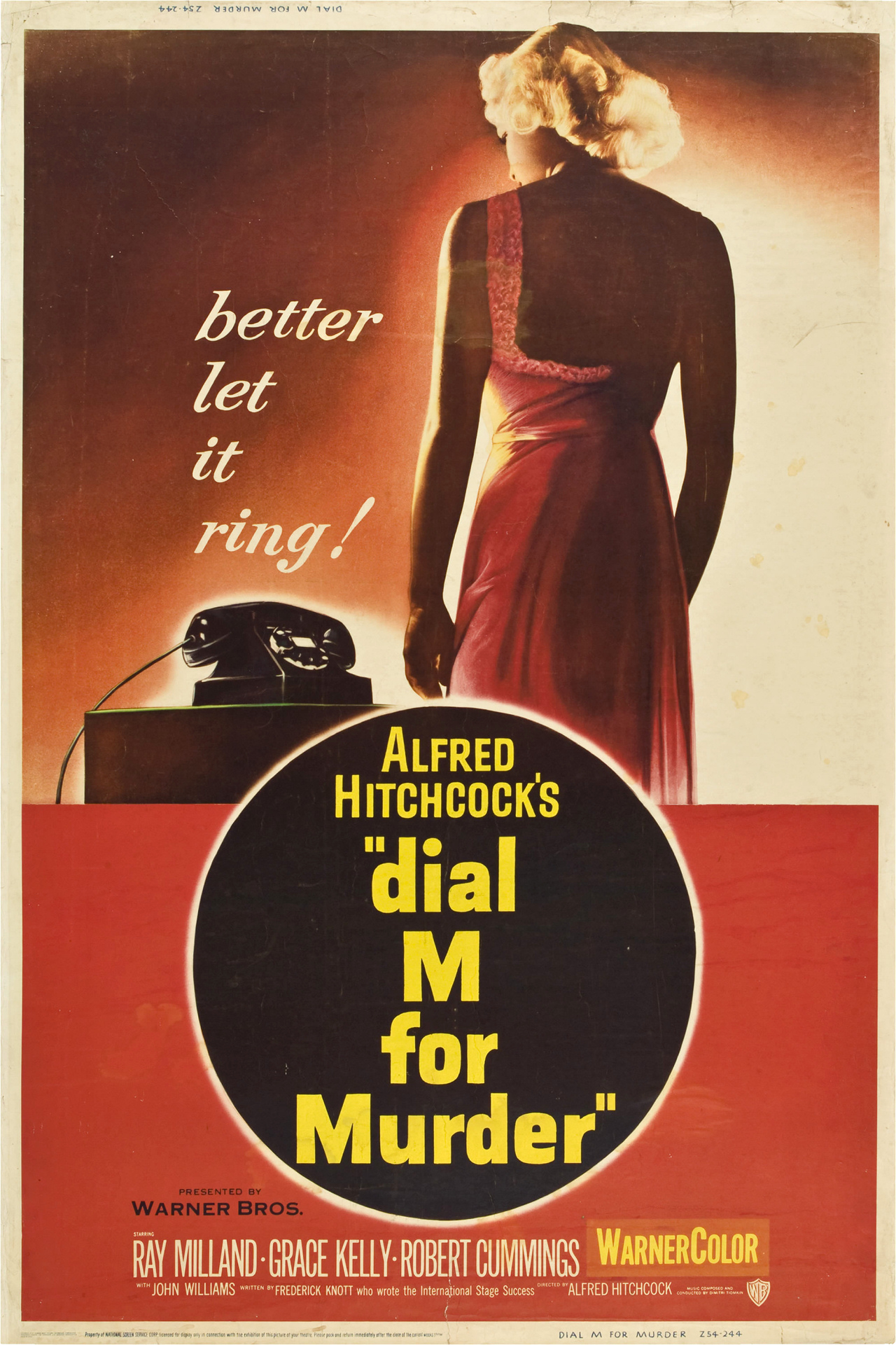
Dial M for Murder, directed by Alfred Hitchcock, one of cinema’s great misanthropes, is playing this week at Chapter Arts Centre. Playing as part of the “Ray Milland Season”, Milland born Reginald Truscott-Jones in Neath, took the name Milland after Neath’s Milland Road, which is now an industrial site come train station car park, oh the Hollywood romance.
Tony Wendice (Ray Milland) a former tennis pro, blackmails an old university chum into murdering his cheating wife Margot. Grace Kelly plays the wife (notice how she first appears in the reddest of rouge dresses, blood and murder are immediately on the mind, notice actually how the colour red is used throughout to denote blood, Hitchcock manages to make a bloody film without any blood), whilst Robert Cummings plays American crime writer Mark Halliday, the man Margot has been carrying on with. The film is an intriguingly complex viewing experience; we want Milland to succeed yet Kelly to survive, we want Milland to be caught but would also revel in his escape, we want Kelly and Cummings to run off together yet we want Milland and Kelly to live happily ever after.
There are at least three reasons to see Dial M for Murder. Firstly, for Grace Kelly, for her tenderness, for her beauty, for her movie stardom, no one photographed her as brilliantly as Hitchcock, see Rear Window for the most beautiful close-up in cinema as she leans in to kiss Jimmy Stewart. Secondly, for Ray Milland, for the devil in his movie star blue eyes and the charisma to his dark scheming murdering plans. Finally, for Hitch himself, for his genius. Primarily for his combination of camera movement and montage, his masterful use of close-ups and inserts, how through a simple close-up of Milland’s hand he manages to convey all the film’s psychology and terror. There are two moments of obvious brilliance in the film, one where Hitchcock films Milland planning the murder from above with a bird’s eye camera, making it all seem like a deadly game of human chess, and secondly a one shot of Kelly as she makes a court appearance which is a sequence of pure visual artistry. Also be on the lookout for Hitchcock’s comedic touches which often go unnoticed in many of his pictures, most notably here in John William’s performance as the Chief Inspector. Lookout for his moustache twirls, his crumpled raincoat, the way he wrestles with Robert Cummings over Milland’s bank statements, but the most brilliant example of Hitchcock black comedy can be found in the little detail of who hands Grace Kelly the now infamous pair of scissors.
Dial M for Murder is a film that gets richer with each viewing. It’s pure Hitchcock which means that it’s pure cinema.
Dial M for Murder (PG)
USA/1954/101mins/PG. Dir: Alfred Hitchcock. With: Ray Milland, Grace Kelly, Robert Cummings
At Chapter Art Centre
– See more at: http://www.chapter.org/dial-m-murderpg#sthash.18HADZga.dpuf
Tuesday July 7th – 2:30pm
Review Beneath the Streets, Lost and Found, Hijinx & Punchdrunk Enrichment by Kaitlin Wray

Punchdrunk theatre are known for physicalising emotions, feelings and scenarios with movement and body language creating contemporary narratives. Their collaboration with Hijinx theatre was stunning to watch. Hijinx and Punchdrunk theatre have collaborated together to create a purely immersive theatre experience. They have transformed the ‘secret’ space into a place fit for exploring. We were led through the doors in groups with a lead giving us an insight into the ‘business’. Then we were allowed to be free to explore to our hearts content (with a few stewards making sure we didn’t go off trail)
Each space had its own story to tell and also its own secrets. Finding out information was difficult but nonetheless every place had their own interesting qualities. The lighting was mainly used by old lamps and candles which added to the atmosphere. The smoke haze added to the eerie effect. The beauty of this performance is that if you went back to the same place there would be an entirely different scenario going on. However I’m not sure if it was my luck or just bad timing but I always seemed to miss an important bit of the story as soon as I got there. There were some lucky individuals that got dragged off and had an even deeper insight to the secrets of the business. Then coming towards the climax of the show we all got ushered into the same room where the finale took place. For me personally I have a lot of guesses to what the overall plot was but I will never know for sure.
The ambiguity is what makes this show individualistic for every audience member. It was exciting to listen to the conversations people had afterwards. This is a show that you might come away from with knowing exactly why everything was happening or come away knowing nothing. However it’s very interesting and a great piece to get lost into. It would be intriguing what it would be like to watch it for the second time.
Preview Everyman Theatre Company Open Air Festival by Lois Arcari
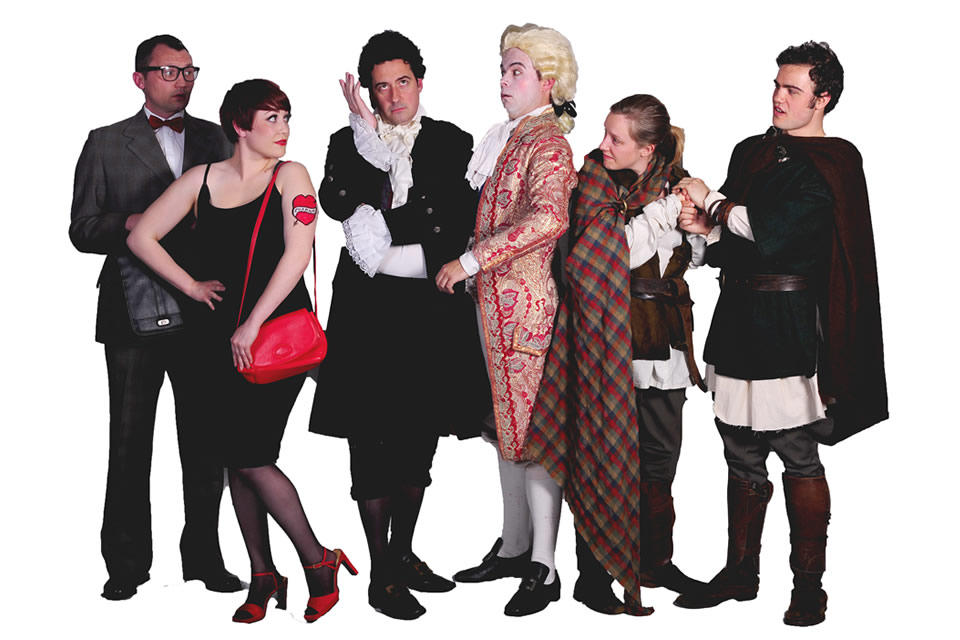
To begin with Blackadder, as much as the classic, written by Richard Curtis, fondly remembered from Atkison’s well remembered turn as the titular character, and Tony Robinson’s zany Baldrick, is loved, so is the new tradition of the Everyman open air theatre company.
Last year’s open air festival gained rave reviews across the board, with talented actors, sharp scripts and scene stealing scenery that worked with the weather, time of day and naturally lovely setting of Sophia Gardens to create a memorable atmosphere throughout.
The regency version of the character holds the task of opening this much-loved festival; running until July the 4th. Praised by the ability of keeping the play as funny as before, taking a bold risk and paying it off as a real crowd pleaser.
After this institution of a comedy makes way for the new play, we are greeted by Sweet Charity, the story of taxi dancer, Charity, holding onto hope that her sleazy life can be traded for a new, romantic one, she falls for actuary Oscar, under the false pretence of being a respectable bank girl – how will he handle the truth in this musical romp, that features the iconic songs Big Spender and the Rhythm of Life.
Next is the turn of Shakespeare, with As You Like It. This comedy features the exiled Rosalind meeting her love, Orlanda in her disguise, with the complications of her gender swap played out in cutting cleverness, in a story whose appeal has stood the test of time.
From centuries to decades again, the festival is rounded out with what’s certain to be a hit with old and new alike, the junior production of Beauty and the Beast. The beautiful, instantly recognisable music against inventive costumes is a production of what many believe is Disney’s finest. With a remake due soon, and countless amounts of merchandise, and audience adoration, this is sure to be a finishing touch that will enchant audience’s.
Following from the resounding success of last year, with a brilliant new line up, and side shows on some Sundays, such as the Forte sing alongs and free junior production of Hamlet, this expansion of the always entertaining festival should find a spot in the time-table of any who love theatre and song.
For more information on the season check out;
http://everymanfestival.co.uk/#/list
Review The Waiting Room Arts Theatre by Hannah Goslin

Arts theatre has created a great concept with some lunchtime theatre. Available for around 40mins in a lunch break, the top floor of this bohemian centre is transformed into a place for people to experience a journey in their break from the daily grind.
I chose to attend this with an interest to the Arts theatre that I had not yet attended and to experience this unique and very versatile idea.
The Waiting Room consisted of a small cast, with the narrative seeing the relationship and mystery of two strangers meeting in a dingy waiting room. We can only assume this is of a doctor or hospital waiting room, until it is revealed in speech of a comparison. This continues the mystery. The two character’s share a unique similarity, one that climaxes the plot. Without revealing this, I found that the narrative was interesting and kept us hooked with essentially a 40min chat. However, when revealed, the mystery isn’t as interesting or climactic as would first appear, struggling to compliment the first three quarters of the storyline.
The main two actors are wonderful, Beth Eyre and Mark Rush. A well spoken, rich woman who lives off money and a male sales assistant or ‘buyer’ for an department store. Both character’s were well executed and complimentary of the narrative. However, an additional two character’s in the form of the ‘receptionist’ or ‘assistant’ and the cleaner were introduced. Till the mystery ending, it seemed as if the receptionist had little purpose – with only 3 appearances and less than a few words spoken, unless an important asset at the end, it seems the main character’s could have directed their conversation to an un-answering body. The same was felt about the cleaner who I did not notice till pointed out; to the side of the room forever shining the Arts Theatre’s mural. It seemed that she was there for a sense of comic relief with a thick broad Scottish accent and laziness despite her comments of being the best cleaner. It felt unneeded and unnecessary and the break from the intense conversation did not gel well to the process.
Overall, The Waiting Room was an interesting concept. The narrative was interesting and the reveal gave an emotional sense, however there was a feeling that there was more to be given and something of great potential.
Review The Elephant Man Theatre Royal Haymarket By Hannah Goslin
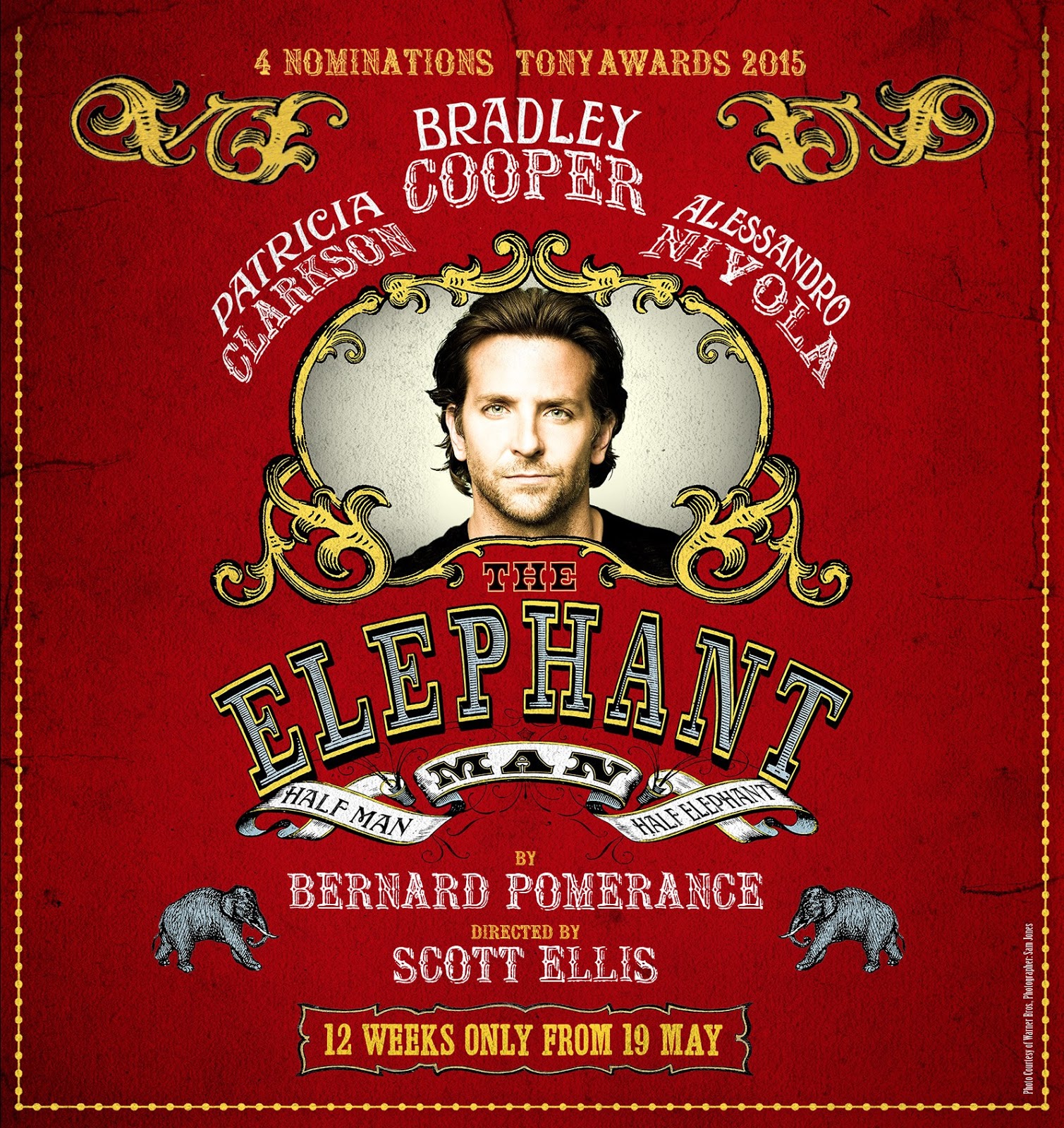
A story in itself that is legendary, The Elephant Man is a true tale that has been told throughout time. With legendary films starring John Hurt and Anthony Hopkins and other performances through time made on the famous man from the 1800’s, the new resurrection in play form has already graced the stage on Broadway; both with Hollywood star Bradley Cooper, it has now made a boom in London.
For those unknown of the story, John Merrick was a true figure in 1800 society who suffered physical deformities from birth. Beginning in the work house and later in the legendary Victorian side shows, when cast out by his carnival ‘partner’, a compassionate and intrigued medical physician, Frederick Treves, takes him in to the London Hospital for analysis. Becoming friends, Treves helps him with funding to live a normal life and give him the opportunity to enter into society, till his eventual death.
Beginning this extraordinary tale, the design of the set was minimal. There was not much need to change the scenes, just simple additions such as a table and chairs, a bath tub and the use of curtains. Lights were simplistic, and while the costumes were true to the era, it could be easy to fall into the trap of making this more realistic to the performances of the time. However, music and sound were used to highlight the beginning and other elements, creating an eerie atmosphere and something relating to the time period but also something modern – this relating to the stage set up once again in avoiding making this a 1800’s production.
What we are all waiting to hear is of the famous Bradley Cooper as Merrick. There is always part of me that is cautious and at times unwilling to like it when large stars take the leading role. While bringing in bums on seat and revenue to the industry, and of course, at times I have already been proved wrong with stars such as Imelda Staunton in Gypsy, it is also a wonder whether this is blocking the way of potentially more talented rising stars. However, like Staunton, Cooper is more than a welcome addition to the role. When someone is able to act as profoundly and incredibly as he does as Merrick, his already abundant stardom is instantly forgiven. With no special effects, lighting, costume or prosthetics to highlight Merrick’s deformities’, Cooper contorts himself from a ‘normal’ human figure, to the character, while Treves speaks from his medical examination of each body part. While some parts of the body as missing such has his enlarged head and sagging skin, this is forgotten as his contortion is so incredible that you can almost imagine it. With his progression to talking and learning the ways of life, Cooper’s British accent is perfection and even more so interesting with the infliction on the ability to speak that Merrick had – his different intonations famous for their unusual expressions.
It cannot be forgotten that the other performers are just as fantastic without the opportunity to completely transform their figure and voice. Alessandro Nivola as Treves shows a stiffness yet much compassion as the character and his love and care for Merrick is emotionally expressive. Next to Cooper, his performance could be understated, but the two actors bounce off each other in a way that we can only imagine the character’s friendship in reality. Patricia Clarkson, another American actress and one of my favourites brought her comedy and, like Nivola, the emotional friendship that the character gains with Merrick. It’s hard to hear the take on the negative character’s with such compassion shown in these positive ones. Only criticism that can be made of the production is the lack of projection of all characters. Not only those who formed articulate pronunciations, Cooper also struggles with Merrick’s affected voice. The large structure of the Haymarket gives struggle to this and at times, words are lost. Perhaps microphone’s are needed, but a personal argument of mine is unless it is for a purposeful effect, theatre needs to return to its’ original form and training of performers to allow their voice to reach their audiences.
The Elephant Man brings everything to the stage with the slight feeling of modernity. Cooper’s performance not only astounds in the sense of showing true acting talent, but the impeccable ability that the human body and one with exceeding talent is capable of. Not only emotional and heart wrenching, this performance also brings realism and truth of such a difficult story.
Life in Close Up: The Other Room’s First Season Overview by Rebecca Hobbs

Life in Close Up: The Other Room’s First Season Overview
Now that The Other Room’s opening season has reached its close, Kate Wasserberg and her team can breath their first sigh of relief after a hugely successful critical and public response to three very unusual plays. Spatially, with just forty-four seats, it was an apt move to shape the first season around the intimate experience that The Other Room offers as the performance sits on top of you wherever you are situated. As a final round up to reflect on the ‘Life in Close Up’ season’s antics and audience appraisals, I had the opportunity to catch up with artistic director Kate Wasserberg and Alun Saunders, the writer of ‘A Good Clean Heart’ to address those niggling questions and observations that struck me during these performances.
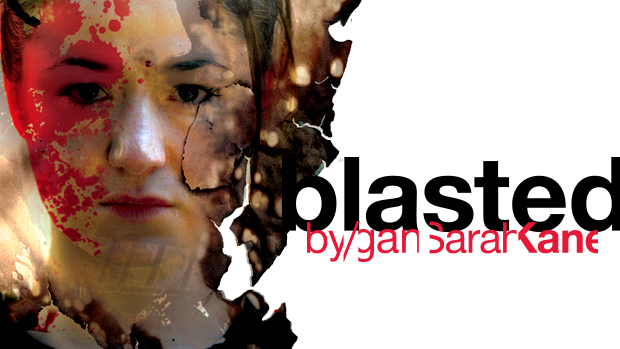
Sarah Kane’s Blasted (1995)
It was bold choice by Kate and the The Other Room team to open the season and the theatre itself with a play that is engulfed in controversial and challenging criticism. The late 90’s reviews had originally brandished Sarah Kane’s Blasted as a sordid and immature piece of writing that for all intensive purposes was written to shock. Despite many of these accusations being revised, launching the ‘Life in Close Up’ season with Blasted instantly stimulated debate and got people talking about what the The Other Room in Cardiff was doing. This was my first piece as a young critic and I had no idea what to expect. After briefly flitting over a Wikipedia synopsis, I initially struggled to grasp the script’s bizarre intentions. However, after seeing it performed as a play rather than reading out a list of violent gimmicks, it became clear that these online summaries are hugely damaging to the play’s reputation; the impact lies within the performance. Despite its controversial standpoint, The Other Room’s production was given a 4* rating by The Guardian and overall it excelled in its reviews from critics who were somewhat shaken but left in awe.
Blasted- A Close up with Kate Wasserberg (Artistic Director)
Q: Recently, with Sherman’s ‘Iphigenia in Splott’ and Chapter’s more ambitious programme, Cardiff theatre seems to have dropped the conservative barrier but a script of this intensity has very rarely been performed on Welsh soil. This was out of Cardiff’s theatrical comfort zone. You clearly had confidence in the script and the fantastic cast. Were you concerned about the play’s notoriety and about challenging the relatively safe expectations of theatre that Cardiff sits comfortably with or did you anticipate that this would fuel its success? Despite the fact that I cannot pretend to have necessarily enjoyed watching Blasted, it was an unforgettable experience and one that has successfully conjured a huge critical response.
Kate: I have always thought of Blasted as a really honest, heartfelt play. Of course I was aware that it is shocking in places and yes that was a conscious decision, to offer up something new. But the main motivation was not so much a response to the arts scene but as a way to attempt to articulate the world as I was experiencing it at the time, not as wholly dark but certainly with cruelty and pain and callousness out there, on the news. The critical response was really varied, and the first few reviews that came out, they really disliked the show and that was quite a raw experience – I can’t remember the last time I have felt so exposed, the cast were giving these incredibly courageous performances and we hadn’t had long to rehearse it really so I felt very protective. But that’s part of doing this play, and approaching it the way we did – head on with no deliberate style. It’s not for everyone and you have to accept that. Of course then more reviews came out and some people did really like it and that was lovely and the audience started to feedback to us and we grew in confidence, but all responses are perfectly valid and that rawness is part of the experience, I think.
Q: Initially, I struggled to distinguish what exactly had bothered me about the play which was odd because the shocking violent junctures are overtly clear and it surprised me that they were not my primary concern. It was the moments of sympathy embedded in the horror, Kate’s uncontrollable laughter and the desperate cry for help read through Ian’s eye contact during the rape. It was the fact that there is never an entire loss of humanity which as an audience member is what you crave in order to dismiss what you have witnessed. Were you specifically conscious about how these moments were going to be directed?
Kate: I think I was, yes. Our starting point as a company was to be as real as possible – to ask, but what if this really was happening? It sounds a bit trite to say it now but in a play that is known for being shocking, it was important for us that the people were complex and human and real. Christian, Louise and Simon were all totally fearless about allowing themselves to go to some very difficult places emotionally and that did take a toll on them at times, but I think they all felt like we were engaged in something quite special and it was worth the vulnerability they felt.
Q: I am sure, particularly with this play, you witnessed a whole spectrum of reactions as people came out of The Other Room. Is there a specific response that stands out to you?
Kate: It was a bit odd in previews – perfectly content, happy people came in and shaken, crying people came out and I genuinely thought, my god, what are we engaged in here? Why do that to people? But of course to be moved is wonderful, even when it’s dreadful. I remember a group early on who really laughed at the jokes, right through to the end, they were wonderful. And an actor friend of mine who literally couldn’t speak, she had to call me the next day. But that’s the play – that’s Sarah Kane and her brilliance. We just tried to do her justice really.
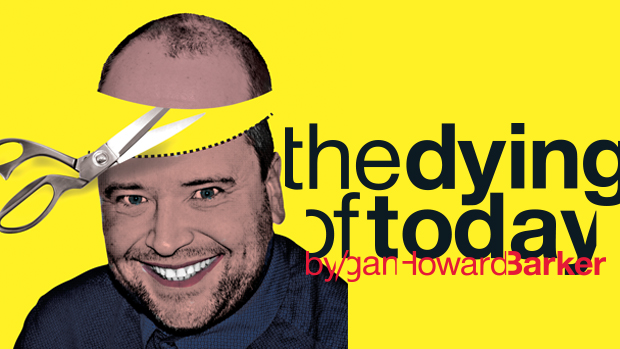
Howard Barker’s The Dying of Today (2008)
After the hype of the first production, expectations were high for the second play in the series, Howard Barker’s The Dying of Today. Inspired by Thucydides’ account of the destruction of the Sicilian expedition during the Peloponnesian War, the play is constructed from that anxiety induced moment of inevitability, considering the worst case scenario in order to deduce how we process the phenomenon ‘bad news’. This was an equally challenging script for entirely different reasons. Barker’s play is stripped of distractions; its plot can be summarised by one line. To keep an audience attentive when the play is entirely based around a conversation with two people in such a mundane environment is a challenge for any director and two man cast.
The Dying of Today- A Close Up with Kate
Q:When I came to see this play, I distinctly remember that I still had half a drink left after the production came to a close. I was immediately drawn into the performance. It almost had a hypnotic effect on me and I think that had a lot to do with the narrative’s rhythmic pace and the fluidity of Leander Deeny and Christian Patterson’s interactions. How did you initially approach this script, was maintaining the momentum a high priority?
Kate: Definitely. We slowed right down in rehearsal to get the detail in but we always had our eye on pace and the confidence with which the ideas develop. It’s acrobatics in some ways, part of the joy is watching them leap from one idea to the next without stopping. Dneister (Leander Deeny) talks for seven minutes without stopping at the beginning of the play and that in itself; to talk ceaselessly and hold the attention of those listening, is a daring feat, especially when the ideas are so complex. Then the barber (Christian Patterson) joins and seems at first to be much simpler and slower but he very quickly builds his own pace and the whole show feels almost like a running race, exploding into physical action with the destruction of the shop.
Q: When the material that is being performed in front of you is as intense as Blasted, the space suddenly becomes very theatrically claustrophobic but for The Dying of Today, the chess board floor manipulates the size of the performance area and it feels deceptively bigger. Has it been a challenge to make the best of such a small space? In this case, what inspired the retro fifties salon? I loved the concept of the audience being the reflection of what we were watching as we sat waiting in anticipation for the news ourselves.
Kate: I definitely wanted the space to feel radically different for each show in the season and for it to be as exciting to walk into The Dying of Today as it was for Blasted, when the audience were seeing the theatre for the first time since the conversion. The 1950’s feel was about tying to distil the essence of a barber’s – a sort of reference that everyone would recognise. We tried to references various time periods throughout to stop the play feeling ‘set’ in a time or place but we also really wanted it to feel like a real shop, that was very important, that these enormous ideas unfolded in this very prosaic environment. But it had a bit of romance too, which was partly about searching for a bit of softness after the rawness of Blasted.
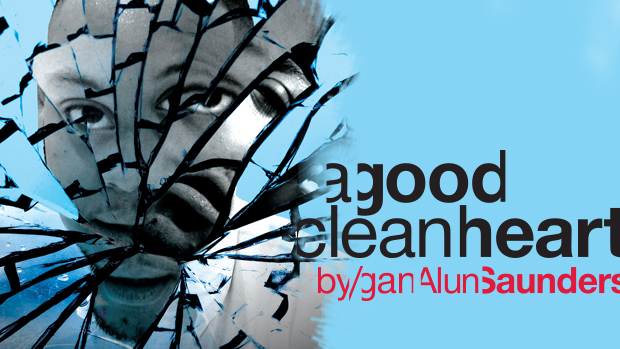
Alun Saunders’ A Good Clean Heart (2015)
The final play in the season was a newly commissioned bilingual work by Alun Saunders, a Welsh writer from Neath who trained as an actor at the RWCMD. A Good Clean Heart addresses a number of challenging questions about our cultural and personal identity but this is a truly unique piece of theatre for its ambitious and playful engagement with language. The play follows the story of two brothers raised in different cultures and familial environments; Hefin, adopted in Wales, well educated and a first-language Welsh speaker and Jay his older brother now living in London with his biological mother who they were originally taken away from. When Hefin is finally told on his eighteenth birthday of a sibling who has been reaching out to him, in a moment of spontaneity he initiates the long awaited meet where the pair struggle to come to terms with the years they have lost. Along with the discovery of his English roots, Hefin is introduced to his brother at a rather inconvenient time with the police waiting for an opportunity to bring Jay back in. The reunited family home is thrown into chaos where mother and sons are forced to make decisions that will impact the rest of their lives.
A Good Clean Heart- A Close Up with Alun Saunders
Q: Firstly, llongyfarchiadau on the incredible success that you have had with ‘A Good Clean Heart’. You must be thrilled with its critical reception?
Alun: Diolch! Thrilled is definitely one of the words… It’s a pretty overwhelming thing pouring your heart into a play without actually knowing how people are going to react. Did I say ‘overwhelming’? I mean terrifying. I imagine even seasoned Writers find it scary putting their work out there for public consumption as they’re under a different sort of pressure – the pressure to ‘keep up the good work’. For me, writing my first full-length play, I wanted to see whether what I had to say, and how I choose to say it, had a place in that public arena. The public and critical reception has absolutely spurred me on to knuckle down and write more. I’m really grateful.
Q: When you were addressing the notion of identity, it came across as a very fluid concept. I loved the intricate ways that this was incorporated into the script with James Ifan and Dorian Simpson jumping into the role of their mother and her boyfriend, drawing out that play on identity crisis. Whilst a national identity is a necessary central focus of the script, were you conscious to avoid restricting the definition of identity?
Alun: Abso-blinkin’-lutely. Having done a good bit of research into how people felt (and how strongly they felt) about their own ‘national identity’, I got such a varied response – some people aren’t bothered at all by it, where some people feel that it absolutely defines who they are. The important thing for me is that people are unique; stereotypes exist, but always with an element of contradiction (I’ve actually been called “a boy full of contradictions” myself). Whilst we constantly try to ‘order’ and categorise other people in order to help ourselves sort the ‘friendly /attractive/ positive’ from the ‘unfriendly/unattractive/negative’, nobody can decide our identity except ourselves. It was important that the characters of Hefin and Jay had a strong identity – even if that changed during the play – and that the audience were allowed to come to their own conclusions.
Q: Finally, in addition to the demanding technical work needed to create that bilingual accessibility, there was also a lot of visual play on language to the point that the words were literally bouncing of the walls. Was the animation of language and the bringing language to life something you enjoyed physically constructing?
Alun: From quite early on in the development of A Good Clean Heart, Kate Wasserberg and Mared Swain the plays director and I had discussions about the technical possibilities of this play. It’s been such a huge collaboration of ideas and skills to bring what was eventually seen to life, and I just feel honoured that so many people’s hard work created this success. For my part, I needed to create characters which the actors (and subsequently, the audience) could believe in, and a story and dialogue to channel that. I was always conscious, whilst writing, of the technical possibilities, so I was interested to see how we could bring a letter, an email and an online chat to life on stage, but the focus was always on where the story was going. Especially by Draft 14…
Kate: Huge praise is due to Zak Hein, who designed the animation, including the subtitling. He worked with Mared to create an incredibly bold visual language for the play that made the bilingualism a joy and also made the show very youthful. I think it worked brilliantly.
Alun: As a Playwright, writing my first full-length play under Kate and Mared’s mentoring has been invaluable. I’ve been pushed to the limits (and beyond) of what I thought I could manage, but seeing the end result has been worth every last blistered typing finger, every tear and 4am coffee. Had I given up four or five drafts ago then my life may, theoretically, have been ‘easier’, but the play we’d have ended up with would have been much weaker for it. I’m really grateful to those whip-cracking slave-drivers for believing in me, and for pushing me to get where we all wanted – only then could we justify the whole team’s hard work. Now to decide where we take it next…
A Final Word on the Season’s success…
Q: The Other Room has clearly hit Cardiff by storm, you must be very happy with the overall response to the first season?
Kate: Of course, we are and incredibly touched and grateful that so many people have supported the project – by coming to the shows, spreading the word and bringing people along. We are so proud to be part of this fantastic city and hope to continue to be worthy of our brilliant audience.
Q: What can we expect next, are there big plans in the pipeline?
Kate: We are putting the finishing touches on our next season and I’m deep into programming 2016. Some very exciting plans and a new way of working – we’ll keep you posted!
The Other Room will be hosting its first Young Arts Festival from 18-20th June where young talents will be showcased through a series of short plays written and performed by all those participating in the week’s festivities. For more information visit: http://www.otherroomtheatre.com/en/whats-on/current-productions/
A huge thank you to Kate and Alun for taking time out of their busy schedules for Young Critics.
Act For Change, National Theatre of Great Britain by Hannah Goslin

Diversity in society is a huge issue to consider. Everywhere is trying to be more encompassing to disabled members of the public, there is more than ever a stamping out of racism and discrimination in all senses.
But why, while much of it is now law, does the arts sector, and notably for this blog post, the theatre, is it not the same?
Act For Change has been alive for around 1 year now, set up by performers who came from what would be known in society as ‘minority groups’. This relates to gender, race, sexual orientation, ability and so on. Its’ aim is to stamp these discriminatory habits even more out of the theatre world.
With testimonies, a Q & A challenging the NT Artistic Director, discussion from a panel and Q & A with the audience, ending on a video of more of those in the industry discussing the subject, AFC covered all basis. And made a real imprint in this industry.
Not enough is being done in encompass disabled performers. While across conference it was a valid consensus that there is an argument of whether the industry should make more theatre showing the stories of individuals in all these sectors or whether casting should be looking for sheer talent and not who they are. While it is a fine line, it seemed that less is being done for disabled performers. Not many are an option, and not much theatre looks at their stories.
A perfect quote I found from the night said, ‘If you want to tell a story you have to tell your own story’.
Different ethnicities, genders and orientations felt the same. Theatre is a way of breaking barriers and addressing taboos and why, on that note, should issues not be addressed that are found in these communities? But why also, are these communities not also celebrated in theatre more? Let’s be honest, many other cultures are more vibrant and exciting that the tweed, tea drinking, white, middle class stereotypes that are continuously produced on stage. Why do we not see this?
Many performers also felt that there was the issue of not being cast because of who they are. Where are the character’s that just happen to be gay? Or female? Or Asian? Does this really need to be such a vital factor? There are gay bankers, female lorry drivers, Asian actors! Why is it that people cannot focus on talent and not on the view of the person entering the room.
Conferences just like these are important to change opinions. Since the blunt interview with the NT artistic director, there has been a change where more theatre is now going to be brought to the NT with a basis on disabled stories and performers, what a difference this makes.
Theatre needs to be not only bring realism and for something for people to admire, but it does need to bring escapism. It needs to stop being run by the elite, and more representative of the people.
More info on Act For Change can be found here;
http://www.act-for-change.com
Review Bara Bread Theatr Gwalia Chapter Arts Centre by Rebecca Hobbs

This week, playwright Carmen Medway-Stephens’ ‘Bara Bread’ starts its run at the Stiwdio at Chapter Arts Centre, Cardiff.
In little Lovenny, due to the passing of Nettie’s mother, the heart and soul of the village, Nettie (Sarah-Jayne Hopkins), is brought back to her childhood roots, a far cry from the city slick fast paced society she now knows. Left for her on the kitchen table is a book of recipes that her mother had put together as a parting gift with a note that reads ‘let us bake bread together’. As Nettie scatters her mothers ashes and makes the mother dough it becomes clear that her abandoned culinary skills are dusty. However, through feeding the mother dough, the bread maker’s answer to the alchemist’s ‘the philosophers stone’, a little magic is sifted into the mix and the understated kitchen table becomes an emblem of hope and honesty where the bread is broken, secrets are shared, barriers are brought down and relationships are rekindled. It becomes clear that the steps of making bread mirror the steps taken in our own lives.
This exploratory narrative of magical realism takes us back to the mode of storytelling where these women’s lives and challenging experiences are shared with one other. Womanism is a term that is rooted in black women’s culture but it is a phrase of solidarity and one that strikes a chord with Carmen Medway-Stephens’ script. The creation of these five women in a little Welsh corner of the globe interacting by creating bread together is the reflected image in Alice Walker’s The Colour Purple of the female community sewing the quilt together, fashioning a unified and supported life for themselves. There is Mair (Olwen Rees) who is discovered to be a larger than life female vicar whose path has faced many challenges, Lara (Saran Morgan), the village’s typical teenage disaster, an endearing young mum who spends her benefits on nappies and a night out in Swansea, Annabel (Michelle McTernan), the village ‘intruder’, botox blitzed and money grabbing and Maggie (Louise Collins), the widowed shepherdess, a recluse who has lost touch with her womanhood since her husband passed away. Despite appearances, as they open up to each other it is clear that life has consumed them all and as they sit kneading the dough together, (like the art of making a good loaf) they share, prove, nurture, feed their souls and grow together.
Alongside a subtle and sensitive soundtrack (with the exception of an unnecessary addition of ‘You raise me up’ at the end), Chris Morgan’s direction is intuitive and fluid; despite the simple home set-up it is a very challenging performance to choreograph. Watching these women physically create this process, you can almost smell the bread cooking. The interactions between these characters are fittingly comical and the concept of born and bred Welsh heritage is aptly personified but the narrative excels because of its strong cast. Michelle McTernan, Olwen Rees, Louise Collins, Sarah-Jayne Hopkins and Saran Morgan bring Carmen Medway-Stephens’ fresh and actively engaging script to life.’
Bara Bread’ raises your spirits, touches your heart and makes you hungry for more.
Review The Ladykillers, Chapter Arts Centre, Cardiff by Barbara Michaels
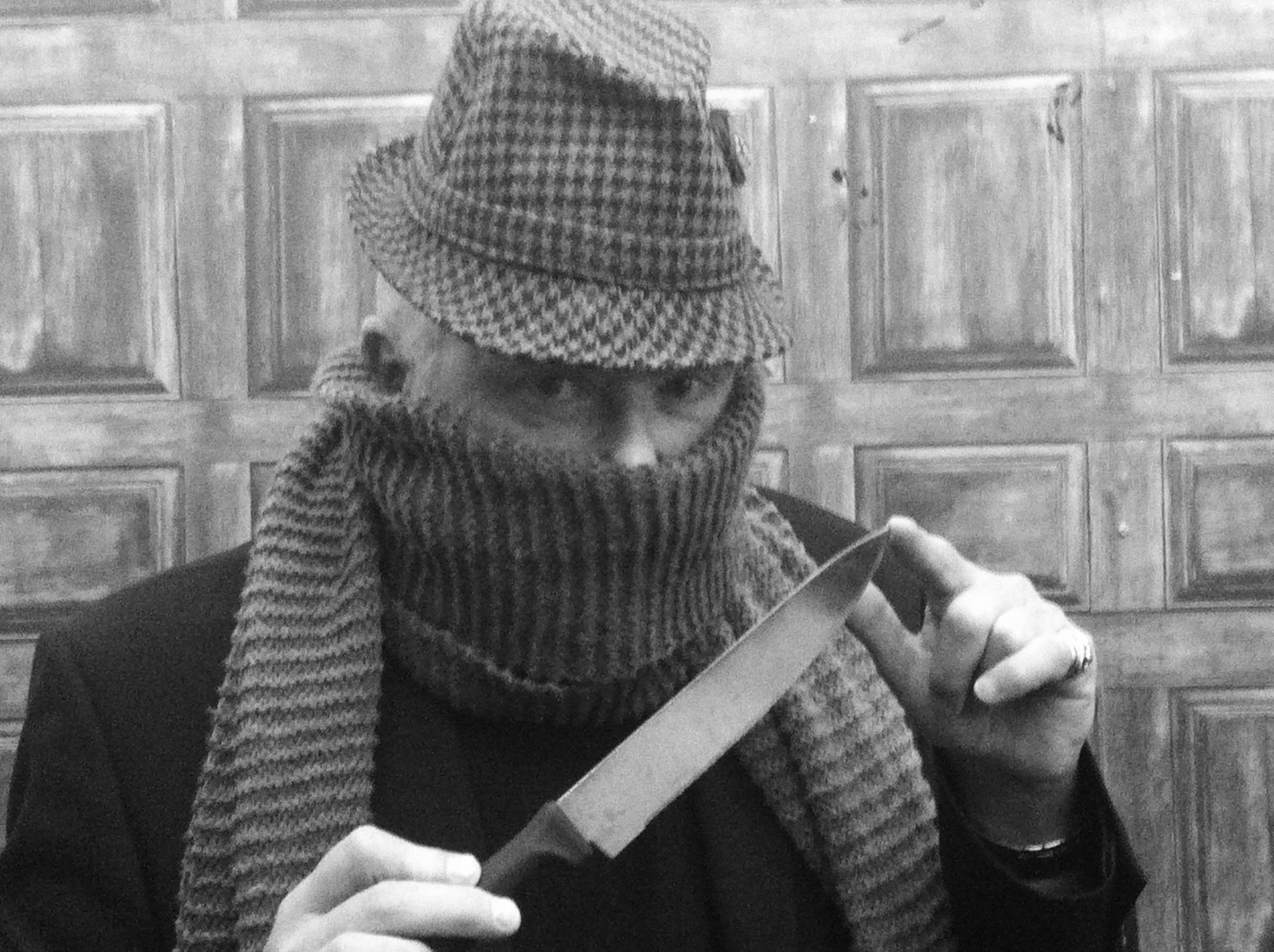
The Ladykillers at Chapter Arts Centre, Cardiff
Original screenplay by William Rose
Adapted by Graham Linehan
Production by Everyman Theatre
Director: Marie-Claire Costly
Reviewer: Barbara Michaels, Third Act Critic
Rating: [3.00]
Murder and mayhem are the buzzwords for William Rose’s comedy-thriller The Ladykillers. For those fortunate enough to have caught a screening of the Ealing Studios 1954 motion picture, Everyman Theatre’s production of the adaptation by Grahan Linehan will bring back fond memories. Who could forget the iconic performance by theatrical icon Alec Guinness as the crafty (and dotty) Professor Marcus?
Take an eccentric old lady living on her own with her parrot and add a gang of crooks masquerading as musicians who rent a room in which to plan a robbery and the scene is set for a series of mishaps. When the old girl, Mrs Wilberforce, discovers what they are up to there is only one solution – to bump her off before she turns them in. But that is not as simple a matter as it might seem – and neither, as it transpires, is the elderly widow who despite her old fashioned appearance might be more than a match for the bumbling ineptitude of the amateur criminals.
Characterisation and pace play a major part in putting on a play of this genre, where a great script full of humour should raise delicious giggles among the audience from start to finish. On opening night this sadly was not the case. It was not until a second half with increased momentum that the performance really got going and we were given a heartening glimpse of what the cast are capable of achieving. It is reasonable to expect things to improve later in the run, for Everyman Theatre has a good track record – their Oh What A Lovely War last year was tops.
As the “master criminal” Professor, Paul Fanning is believable although relying overmuch on twiddling his overlong scarf. Not quite dotty enough for this critic, although the Prof’s darker side is well presented in Act II. As for the rest of the gang, Steve Smith’s sharp suited Mafia-type Louis is spot-on and Arnold Phillips suitably military as Major Courtney. As Harry, the youngest of the crooks, Sion Owen settles into the role nicely in the second half.
Now we come to Mrs Wilberforce, played by Ruth Rees who admirably displays both the mobility problems of increasing age, limping around the stage as is suitable for one later described as Mrs Lopsided, and the finickiest of advancing age in another era. Nevertheless, Rees’s portrayal is still a tad too lively for the part – a few more wrinkles added in make-up might help. Loved the costume, though, particularly in the tea party scene and the posse of old ladies is fun – Lynn Hoare gets it just right as the gushing Mrs Tromleyton.
Full credit to the set designers for their clever use of every area of the stage and for props for some wonderful touches – wonky picture, grandfather clock et al, not to mention the interesting musical instruments.
Runs until Saturday May 23rd.
